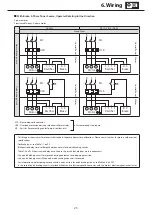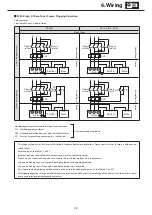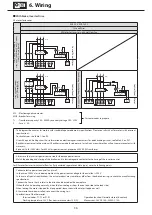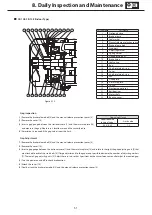
36
37
6. Wiring
6-6 Points to Note When Using a Quick Braking Circuit
When using brakes with quick braking circuits, take note of the following items.
- Connect a varistor (protection element) to protect the quick braking circuit contact points from surge Voltage generated by the brake
action.
- Wire the quick braking circuit contact points to secondary side contacts of the brake power source. If not, contact points might not be
protected.
- For information on using an alternating current electromagnetic contactor as contact points for quick braking circuits, see Table 6-4.
If multiple contact points are required, note the following issues.
- Connect electromagnetic contactor contact points in serial. (See Figure 6-3)
- Connect the varistor (VR) as close to the unit as possible. (See Figure 6-3)
Table 6-4 Nomenclature for Parts Recommended When Using a Quick Braking Circuit (When Using an Alternating Current Electromagnetic Contactor).
AC
Voltage
Brake Type
Recommended Contactor Nomenclature
Recommended
Contactor
Contact Point
Capacity
(DC-13 Class)
Recommended Varistor
(For Protecting Contactor Contact Points)
Made by Fuji Electric FA
Components &
Systems Co., Ltd.
Made by Mitsubishi
Electric Corporation
Varistor Type
Maximum
Allowable
Circuit
Voltage
Varistor
Voltage
Power
Rating
200V
220V
FB-05A1
SC-05
Serial contact
points: 1
(0.7A)
S-N11
or
S-N12
Serial contact
points: 1
(1.2A)
DC
110V
Minimum
0.5A
TND07V-471KB00AAA0
AC300V
470V
(423 -
517V)
0.25W
FB-1D
Minimum
0.7A
TND10V-471KB00AAA0
0.4W
FB-1E
FB-1HE
SC-05
Serial contact
points: 2
(3.0A)
S-N11
or
S-N12
Serial contact
points: 2
(3.0A)
Minimum
1.5A
TND14V-471KB00AAA0
0.6W
FB-2E
FB-3E
FB-4E
FB-5E
SC-05
Serial contact
points: 3
(4.0A)
S-N18
Serial contact
points: 3
(5.0A)
Minimum
3.0A
FB-8E
FB-10E
SC-5-1
Serial contact
points: 3
(10A)
S-N20
or
S-N21
Serial contact
points: 3
(10A)
Minimum
5.5A
TND20V-471KB00AAA0
1.0W
FB-15E
FB-20
Minimum
4.5A
FB-30
ESB-250
ESB-250-2
400V
440V
FB-05A1
SC-05
Serial contact
points: 2
(0.4A)
S-N11
or
S-N12
Serial contact
points: 2
(0.5A)
DC
220V
Minimum
0.3A
TND10V-821KB00AAA0
AC510V
820V
(738 -
902V)
0.4W
FB-1D
SC-05
Serial contact
points: 3
(2.0A)
S-N11
or
S-N12
Serial contact
points: 3
(2.0A)
Minimum
0.5A
TND14V-821KB00AAA0
0.6W
FB-1E
FB-1HE
Minimum
1.0A
TND20V-821KB00AAA0
1.0W
FB-2E
FB-3E
FB-4E
FB-5E
S-N18
Serial contact
points: 3
(2.0A)
Minimum
1.5A
FB-8E
FB-10E
-
-
S-N20
or
S-N21
Serial contact
points: 3
(4.0A)
Minimum
3.0A
FB-15E
FB-20
Minimum
2.5A
FB-30
- This recommended contactor nomenclature is for Fuji electric FA Components & Systems Co., Ltd. and Mitsubishi electric Corporation
contactors. products from other manufacturers are Also allowable If they have equivalent capabilities.
- Recommended contactor contact point capacity indicates the case where durability regarding electronic opening and closing (service
life) is approximately 2 million times (for FB-30, ESB-250, ESB-250-2 approximately 1 million times).
- Of the recommended contactors, the Mitsubishi Electric Corporation S-N11 has one auxiliary contact point; the S-N18 has none. Please
note that these 2 contractors are not usable when two or more auxiliary contact points are required for inverter drive and so on. (Other
connectors in Table 6-4 have two or more auxiliary contact points.)
- This recommended varistor nomenclature is for Nippon Chemi-Con Corporation varistors. Products from other manufacturers are also
allowable if they have equivalent capabilities.
- In the FB-20, 30, ESB-250 and 250-2, a varistor for protecting the connector contact points is built in to the rectifier.
Figure 6-3 Examples of Contact Point Connections with Quick Braking Circuits
VR
Brake terminal N
U phase
MC
Rectifier terminal 6
Rectifier terminal 5
Rectifier terminal 2
Rectifier terminal 2
Rectifier terminal 2
MC
VR
Brake terminal N
U phase
MC
Serial contact points: 1
For FB-05A1〜FB-15E
For FB-20、FB-30、ESB-250、ESB-250-2
Serial contact points: 2
Serial contact points: 3
Serial contact points: 3
MC
VR
Brake terminal N
U phase
note
note
note
For inverter drives, connect to the L1 phase or R phase (power source side).
















































